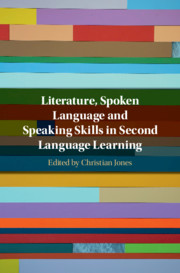Book contents
- Literature, Spoken Language and Speaking Skills in Second Language Learning
- Literature, Spoken Language and Speaking Skills in Second Language Learning
- Copyright page
- Contents
- Figures and Tables
- Contributors
- Foreword
- Acknowledgements
- 1 Introduction
- Part I Literature and Spoken Language
- 2 The Realism of Conversation in Literature
- 3 Using Literature in Text-Driven Materials to Help Develop Spoken Language Awareness
- 4 Literature, TV Drama and Spoken Language Awareness
- 5 Haiku and Spoken Language: Corpus-Driven Analyses of Linguistic Features in English Language Haiku Writing
- 6 Screenplays as a Pedagogical Medium for Cultivating EFL Learners’ Metapragmatic Awareness of Speech Acts in Spoken English
- Part II Literature and Speaking Skills
- Index
- References
4 - Literature, TV Drama and Spoken Language Awareness
from Part I - Literature and Spoken Language
Published online by Cambridge University Press: 18 October 2019
- Literature, Spoken Language and Speaking Skills in Second Language Learning
- Literature, Spoken Language and Speaking Skills in Second Language Learning
- Copyright page
- Contents
- Figures and Tables
- Contributors
- Foreword
- Acknowledgements
- 1 Introduction
- Part I Literature and Spoken Language
- 2 The Realism of Conversation in Literature
- 3 Using Literature in Text-Driven Materials to Help Develop Spoken Language Awareness
- 4 Literature, TV Drama and Spoken Language Awareness
- 5 Haiku and Spoken Language: Corpus-Driven Analyses of Linguistic Features in English Language Haiku Writing
- 6 Screenplays as a Pedagogical Medium for Cultivating EFL Learners’ Metapragmatic Awareness of Speech Acts in Spoken English
- Part II Literature and Speaking Skills
- Index
- References
Summary
This chapter reports on research in a study abroad context at a UK university. It centres on the use of literature which has been dramatised on television (the popular TV series Sherlock) and how this can be harnessed to develop a greater awareness of typical features of spoken language – in this case the use of ellipsis. An experimental study was undertaken which compared the results of three groups: one receiving explicit instruction plus input enhancement (experimental group 1), one receiving explicit instruction only (experimental group 2) and a control group who received no instruction. Both treatment groups worked with three short extracts from Sherlock over three lessons and were given explicit instruction, comprehension tasks and exercises to raise awareness of several features of spoken language, including ellipsis, requesting and modality. The experimental groups received the same explicit teaching (here understood as the teacher making it clear to the students what the lesson focus was), but experimental group 1 also had their transcripts enhanced via textual enhancement to highlight the aforementioned features of spoken language. Results were measured using a comprehension test and a test which measured receptive knowledge of ellipsis in spoken language administered at a pre-, post- and delayed test stage, which was 3 weeks after the classes. In addition, six members of each experimental group took part in a focus group to discuss the extent to which participants found the classes helped to develop awareness of ellipsis and how useful and motivating they found the literature materials to be. Results show clear effects for instruction, with significant gains made over time on the receptive tests for experimental group 1 when compared to the control group. However, no significant difference between treatment types was shown in the post- and delayed tests. Focus groups indicated that participants found the dramatised literature materials to be motivating and useful, and they also reported some noticing of ellipsis in their contact with English outside class time.
- Type
- Chapter
- Information
- Publisher: Cambridge University PressPrint publication year: 2019
References
- 1
- Cited by



